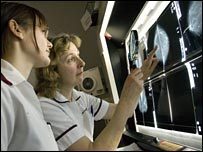One-Third of Breast Cancers Change When They Travel
by
Brendon Nafziger, DOTmed News Associate Editor | November 10, 2009

New findings in breast cancer
Over one-third of breast cancers change when they travel from the breast to other parts of the body, a fact treatment protocols might have to take into account when planning therapies for breast cancers that have migrated, according to a paper published online Wednesday in the Annals of Oncology.
Researchers at Breakthrough Breast Cancer Research Unit at the University of Edinburgh in Scotland examined 211 tumors from underarm lymph nodes that had originated in the breast, and discovered that 39 percent of primary tumors changed hormonal or protein receptor expression when they migrated to the node.
"It is a largely neglected area of study, partly because pathologists assume that the disease doesn't change (significantly) with spread. However, our data show that this isn't the case," Dana Faratian, M.D., lead author of the paper and a researcher with Breakthrough Breast Cancer, tells DOTmed News.
When the primary tumor's cells reached the node, the scientists found that populations of receptors for hormones and other chemical signals could change. Estrogen and progesterone receptors in the cancer could switch from positive to negative, and vice versa.
Tellingly, about one in ten tumors showed changes in expression of Human Epidermal growth factor Receptors 2 (HER2).
"We know that tumors have to change in order to gain access to lymphatics and vessels," Faratian notes. "As a key oncogene, HER2 may be part of the underlying molecular change that drives this in a proportion of cases, and sets the scene for movement to lymph nodes."
Of course, such changes could have huge implications for treatment. Knowing the exact nature of the nodal growth could help doctors choose the drug that best fits the type of cancer present, which could increase survival rates and reduce unnecessary side effects, the study's authors argue.
For instance, ER-positive cancers won't respond to cancer-drug tamoxifen, but ER-negative ones will, while ER-negative tumors don't usually respond to hormone therapy, unlike ER-positive ones. And HER2-expressed tumors often fall to the drug trastuzumab (trade name: Herceptin), Faratian notes.
"I think that this most definitely [will result in] practice changing," argues Faratian. "As pathologists, we already have nodal tissue available to us from sentinel node biopsy, axillary sampling, or axillary clearance. We can perform the same tests on these tissues as we already do on the primary tissue. Therefore, although there is a cost associated with this, it is relatively small compared to giving the right drug to the right patient," she explains. "In the clinic treatment, decisions could be modified for a few people quite quickly."
Dr. Faratian does note that there is a very small chance that because of the sampling techniques used some of the HER2 positive receptor populations in the original tumor are not detected, which means the change in that population in the nodal tumor might be smaller than it appears in the study. However, she says her sampling method gets the whole tumor in more than 95 percent of all cases.
"Ultimately the answer to whether this changes outcomes for women needs to be tested in a clinical trial," she concludes.
